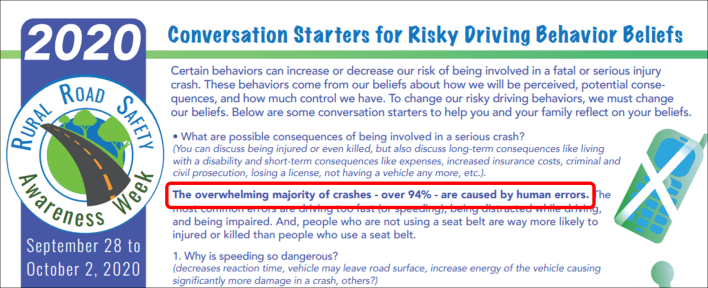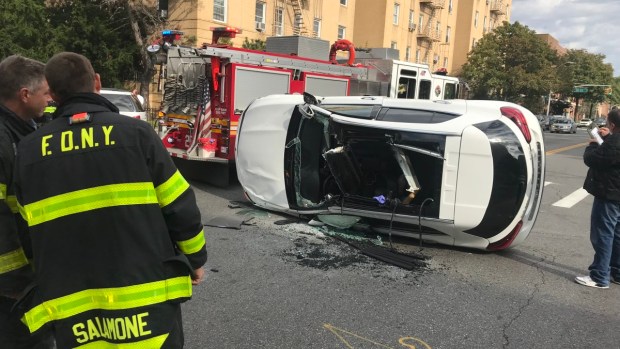You’ve probably heard the claim that 94 percent of crashes are due to human error. Traffic safety campaigns are grounded in that claim. Agencies are using it to advocate for autonomous vehicles with the promise that eliminating human error means crashes will practically disappear. Engineers use it to out-source blame instead of fixing system design errors.
Simply put: It’s not true. Crashes are more complex than that and we need to understand all those factors to stand a chance at reducing traffic deaths in the United States.
"We need to debunk the 94 percent myth because it detracts focus from the actual risk factors that are most deadly, such as poorly designed roads and dangerously high speed limits,” said Vision Zero Network Director Leah Shahum, whose organization is starting a social media campaign to get agencies and traffic safety campaigns to stop using it. “This myth keeps communities from implementing effective policy and design solutions, which is literally killing people, especially our most vulnerable road users, including: children, seniors, people with vision impairments, and those walking and biking.”
Origins of the 94 percent claim
The National Highway Traffic Safety Administration’s Critical Reasons for Crashes Investigated in the National Motor Vehicle Crash Causation Survey is the primary source for the claim. But the administration itself makes it clear that the 94 percent statistic should not merely be used in a vacuum (emphasis added):
The critical reason is the immediate reason for the critical pre-crash event and is often the last failure in the causal chain of events leading up to the crash. Although the critical reason is an important part of the description of events leading up to the crash, it is not intended to be interpreted as the cause of the crash nor as the assignment of the fault to the driver, vehicle, or environment.
Yet organizations still flaunt NHTSA by citing human error as the cause of crashes.
It starts at the top, with U.S. Transportation Secretary Elaine Chao. In January, 2018, Chao told Fox Business Network that “94 percent of accidents occur because of human error.” And last year, she used the false statistic to advocate autonomous vehicles.
Elaine Chao says at #mEnabling19 that 94% of vehicle crashes are caused by human error. pic.twitter.com/nXVP2KHZf4
— Jon Avila🇺🇦 (@JonAvilaA11y) June 18, 2019
There are others:
- The national organization of state DOTs, also known as the American Association of State Highway and Transportation Officials, defied the NHTSA in this YouTube video in early 2020 to showcase the agency’s commitment to safety, stating that it wants to reduce or eliminate human error, “the cause of 94 percent of all serious crashes.”
- AASHTO used it again in this December, 2019, Facebook post, stating, “According to NHTSA, 94 percent of crashes are caused by human error.”
- The Governors Highway Safety Association — a national traffic safety organization comprised of state traffic safety offices, auto industry organizations, insurance companies, and others — has used it several times in its Twitter feed. (The GHSA declined to comment.)
- Drive Ohio, the Ohio DOTs smart mobility hub, uses the 94 percent claim on the first page of its 2020 Annual Report chapter “Focus on Safety” to justify autonomous vehicles: “According to the National Highway Traffic Safety Administration, when automated vehicles are added to the crash equation, the factor of human error can then be omitted from it. This same factor is what leads to 94 percent of serious crashes in the United States.”
- Utah DOT also used the 94-percent claim it in its promotional videos for autonomous vehicles (it's at :49 in this YouTube video) and as recently as Sept. 10 of this year, UDOT is cited as claiming 94 percent of crashes are due to human error in this piece about technology. (Utah DOT declined to comment.)
- The National Center for Rural Road Safety, a consortium of universities and consulting firms funded by Federal Highway Administration and based at Montana State University, just rolled out “Rural Road Safety Awareness Week” with a conversation starter: “The overwhelming majority of crashes —over 94 percent — are caused by human errors.”
- Iowa DOT’s “Zero Fatalities” campaign ignores NHTSA's disclaimer with this statement on its website: “94 percent of crashes are caused by human error.
The Iowa DOT Director of Traffic & Safety, Steve Gent, said the agency uses the 94 percent stat merely as a way of "generalizing the results from this study and in no way are we referencing any individual crash or case. We are using this research to educate ourselves and others as to the best estimated cause of crashes in our country.”

Fixing the error
Use of the erroneous claim cannot be blamed solely on DOTs. NHTSA is just as guilty for misusing it as a way to advocate for autonomous vehicles. In a July, 2017, hearing before the House Transportation Committee, NHTSA President Jack Danielson defied his own agency’s caution about using the 94 percent statistic, telling members of Congress, “We do know that over 90 percent of serious crashes are due to human choice and error.”
And NHTSA’s Automated Vehicles for Safety website states: “Automated vehicles’ potential to save lives and reduce injuries is rooted in one critical and tragic fact: 94 percent of serious crashes are due to human error.”
I found that NHTSA site with the help of Matt Bruning, the spokesman for the Ohio DOT, after I tweeted a link to the Drive Ohio publication. Bruning then sent me several links showing NHTSA using the claim in ways NHTSA says it shouldn’t be used.
Our exchange revealed that Ohio DOT is at least starting to question the statistic. The 94-percent claim, Bruning said, is “a figure that's widely used, but we've heard some interesting feedback about why it may not tell the whole story. … It's one reason we're working with some cities in Ohio on Vision Zero [Columbus and Cleveland]. However, we also know that all the engineering solutions we put into place are meaningless if drivers don't pay attention and drive responsibly.”
That’s what we should expect from out state DOTs.

The real litmus test for agencies like Ohio DOT will be the next step, as outlined in its Vision Zero materials: “Finally, when some road users inevitably fail to follow the rules … designers must take necessary steps to ensure that the resulting crashes do not result in people being killed or seriously injured.”
In May, I sent a lengthy email to Patrick McKenna, director of the Missouri DOT and currently AASHTO's president, asking him to explain the group's use of the 94-percent claim. I cited the AASHTO video I linked in this story, as well as his speech at this year’s Transportation Research Board conference.
McKenna got back to me on Sept. 24: “As with the NHTSA statistic being the intent of identifying critical reasons in crashes, my intent in using this statistic is not to assign fault, but to stress the part that we all play in eliminating fatalities and serious injuries — both safety professionals from all disciplines and road users themselves.”
The problem is McKenna and his organization do use the statistic to assign fault.
In February, McKenna testified before the Senate Committee on Banking, Housing and Urban Affairs and misled legislators by stating, “It is estimated that over 90 percent of fatal vehicle crashes are a result of human error.”
Accounting for human error
This does not mean human error is absent from crashes. I have no reason to doubt NHTSA’s finding that human error plays a major role in the last critical reason among many contributing factors in a crash. Consider this scenario as you think of that last critical reason:
A driver is moving at 40 mph on a road posted at 30 mph, but engineered to be forgiving to the driver at 40 mph. The driver, who recently traded their Prius for a Ford F150, then makes a high-speed turn at a signalized intersection onto a road with corner radii designed to allow high-speed turns. The light is green for the driver, which means the person crossing the street parallel to the driver’s previous direction has the WALK signal as the driver turns across their path. It’s at night on a poorly-lit intersection with a low-visibility crosswalk. The person on foot is hit. The velocity and height of the vehicle is such that the impact is fatal to the person in the crosswalk.
The “critical reason” for the crash would be cited as the driver’s error in failing to yield to the pedestrian. If that couldn't be proved, the “critical reason” might be pedestrian error. In either case, it doesn’t account for the numerous engineering factors of the road and vehicle that made that situation fatal.
Even if we fixed all those engineering factors, human error might still be the critical reason for the crash occurring. However, in fixing those engineering factors and vehicle design issues we stand a good chance of making sure that the crash result does not result in death or disabling injury of the person who is walking.
That’s what Vision Zero is about. Vision Zero Network outlined where human error sits in overall safe systems paradigm in its 2017 report, MOVING FROM VISION TO ACTION: Fundamental Principles, Policies & Practices to Advance Vision Zero in the U.S.: “First, the designers of the system are responsible for the design, operation, and use of the transportation system. Second, road users are responsible for following the rules of the transportation system.”
“One hundred preventable traffic deaths a day is not primarily an individually caused problem, and we won't make a real difference in protecting our loved ones by looking to solutions that are primarily individually led,” said Shahum. “This is why the Safe Systems approach that Vision Zero is built on calls for far less dependence on enforcement and education strategies, which are mostly individually-oriented, and far more emphasis on engineering and policy solutions."






